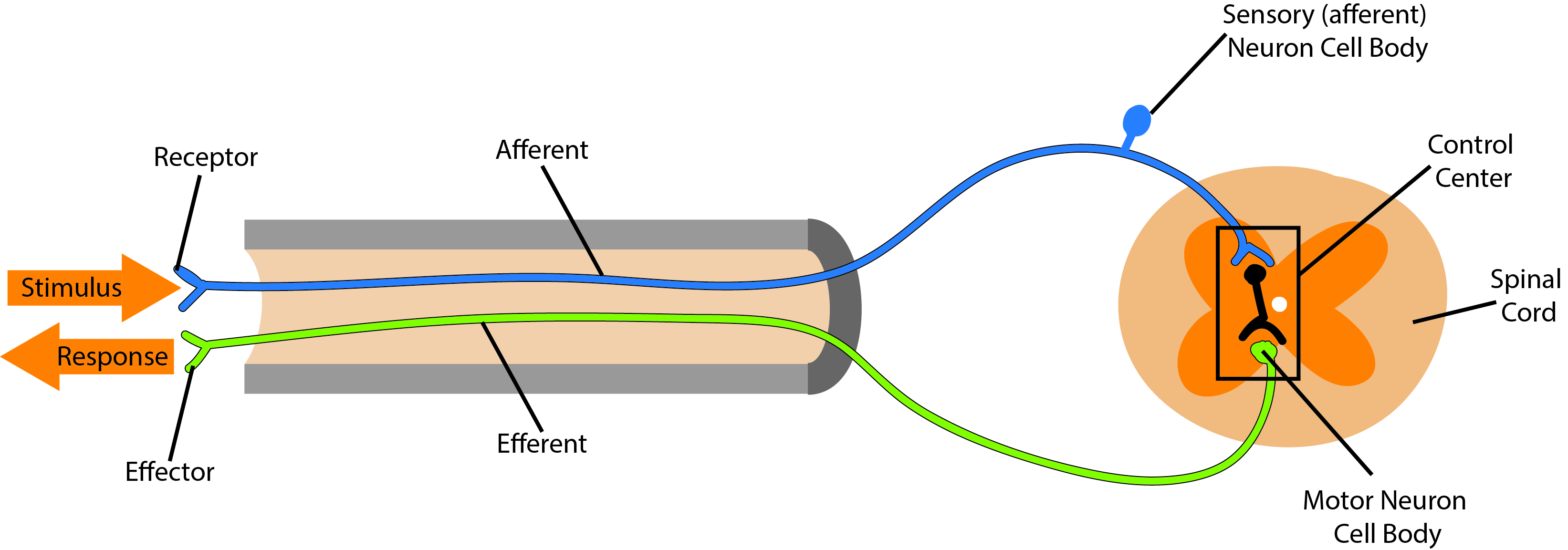CONTROL OF BODY MOVEMENT
REFLEXES
Recall from module one the importance of homeostasis. Reflexes are the mechanism whereby the body is able to sense changes and respond appropriately in order to maintain homeostasis. Reflexes take place automatically and unconsciously for good reason. Can you imagine what your life would be like if you had to think about the temperature of the room you just entered and then make conscious adjustments in order to maintain your internal temperature within the normal range? In order to understand how reflexes work we will examine the basic components of a reflex arc and how they interact to generate the desired effect.
Reflexes can be classified in many different ways, but we will examine them as either somatic: involving control of skeletal muscle, or autonomic: involving control of smooth muscle, cardiac muscle, glands etc. Regardless of their classification, all reflexes have 5 basic components:
1) A receptor that detects change. Here are the different types of receptors we see in the body:
- A mechanoreceptor is a sensory receptor that responds to mechanical pressure or distortion. Touch, pressure, stretching, sound waves, and motion can all activate mechanoreceptors.
- A chemoreceptor detects certain chemical stimuli in the environment. For example, chemoreceptors in the carotid artery are sensitive to the partial pressure of carbon dioxide in the blood; they signal the respiratory center in the brain to increase or decrease the rate of breathing. The sensations of smell and taste happen because of chemoreceptors located in the sensory organs of your body.
- Thermoreceptors are specialized nerve cells that are able to detect differences in temperature.
- Photoreceptors are the cells in the retina that respond to light. These receptors convert light into signals that give us our vision.
- Nociceptors are sensory receptors that detect signals from damaged tissue or the threat of damage and indirectly also respond to chemicals released from the damaged tissue by sending signals to the spinal cord and brain. Nociceptors conduct signals that are generally perceived as pain.
2) An afferent or sensory neuron that relays information.
3) A control center that evaluates the incoming information and determines an appropriate response.
4) an efferent or motor neuron that carries information away from the control center.
5) An effector where the action is carried out.
These components form a basic circuit that is called a reflex arc. The control center portion of the reflex arc can be quite simple (as in the synapse of an afferent neuron onto an efferent neuron in a stretch reflex), but it is often more complex involving one or more interneurons. Simple reflexes involving a single synapse between two neurons are termed monosynaptic, whereas reflexes involving two or more synapses are termed polysynaptic. We will examine several types of somatic and autonomic reflexes because of their clinical significance. However, please keep in mind that this is not an exhaustive list, and there are many other significant reflexes.

Image created by JS at BYU Idaho F2013.
**You may use the buttons below to go to the next or previous reading in this Module**


